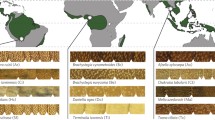Abstract
The effects of atmospheric CO2 enrichment on mature trees in their natural environment are largely unknown. Here we present a new, and inexpensive technique which can be used in situ to address some key physiological questions related to the CO2 problem. Small, light-weight cups mounted on the lower side of rigid leaves at the top of tall tropical forest trees were supplied with CO2-enriched air derived from a low-technology air mixing device utilizing forest floor CO2 evolution. We present the scientific rationale for such field experiments, technical details, an assessment of potential cup artifacts and first results illustrating effects of elevated CO2 on stomata and carbohydrate accumulation in the canopies of mature trees.
Similar content being viewed by others
References
Barton CVM, Lee HSJ, Jarvis PG (1993) A branch bag and CO2 control system for long-term CO2 enrichment of mature sitka spruce (Picea sitchensis (Bong.) Carr.). Plant Cell Environ 16:1139–1148
Bazzaz FA, Fajer ED (1992) Plant life in a CO2-rich world. Sci Am 266:68–74
Cowan IR, Troughton JH (1971) The relative role of stomata in transpiration and assimilation. Planta 97:325–336
DeLucia EH, Sasek TW, Strain BR (1985) Photosynthetic inhibition after long-term exposure to elevated levels of atmospheric carbon dioxide. Photosynth Res 7:175–184
Dufrène E, Pontailler J-Y, Saugier B (1993) A branch bag technique for simultaneous CO2 enrichment and assimilation measurements on beech (Fagus sylvatica L). Plant Cell Environ 16:1131–1138
Eamus D, Jarvis PG (1989) The direct effects of increase in the global atmospheric CO2 concentration on natural and commercial temperate trees and forests. Adv Ecol Res 19:1–55
Ellsworth DS, Oren R, Huang C, Phillips N, Hendrey GR (1995) Leaf and canopy responses to elevated CO2 in a pine forest under free-air CO2 enrichment. Oecologia 104:19–146
Farrar JF, Williams ML (1991) The effects of increased atmospheric carbon dioxide and temprature on carbon partitioning, source-sink relations and respiration. Plant Cell Environ 14:819–830
Field CB, Jackson RB, Mooney HA (1995) Stomatal responses to increased CO2: implications from the plant to the global scale. Plant Cell Environ 18:1214–1225
Gifford RM (1992) Interaction of carbon dioxide with growth-limiting environmental factors in vegetation productivity: implications for the global carbon cycle. In: Stunhill G, Dagan B (eds) Advances in Bioclimatology 1. Springer, Berlin Heidelberg New York, pp 24–58
Körner Ch, Arnone JA III (1992) Responses to elevated carbon dioxide in artificial tropical ecosystems. Science 257:1672–1675
Körner Ch, Miglietta F (1994) Long term effects of naturally elevated CO2 on mediterranean grassland and forest trees. Oecologia 99:343–351
Körner Ch (1996) The response of complex multispecies systems to elevated CO2. In: Walker BH, Steffen WL (eds) Global change and terrestrial ecosystems. Cambridge University Press, in press
Körner Ch, Pelaez-Riedl S, Bel AJE van (1995) CO2 responsiveness of plants: a possible link to phloem loading. Plant Cell Environ 18:595–600
Mooney HA, Drake BG, Luxmoore RJ, Oechel WC, Pitelka LF (1991) Predicting ecosystem responses to elevated CO2 concentrations. BioScience 41:96–104
Norby RJ, O'Neill EG, Wullschleger SD (1995) Belowground responses to atmospheric carbon dioxide in forests. In: McFee WW, Kelly JM (eds) Carbon forms and functions in forest soils. Soil Science Society of America, Madison, Wisconsin, pp 397–418
Stitt M (1991) Rising CO2 levels and their potential significance for carbon flow in photosynthetic cells. Plant Cell Environ 14:741–762
Teskey RO (1995) A field study of the effects of elevated CO2 on carbon assimilation, stomatal conductance and leaf and branch growth of Pinus taeda trees. Plant Cell Env 18:565–573
Tognetti R, Giovanelli A, Longobucco A, Miglietta F, Raschi A (1996) Water relations of oak species growing in the natural CO2-spring of Rapolano (Central Italy). Ann Sci Forestier 53 (in press)
Wong SC (1990) Elevated atmospherical partial pressure of CO2 and plant growth. II. Non-structural carbohydrate content in cotton plants and its effect on growth parameters. Photosynth Res 23:171–180
Wong SC, Cowan IR, Farquhar GD (1979) Stomatal conductance correlates with photosynthetic capacity. Nature 282:424–426
Wulff RD, Strain BR (1982) Effects of CO2 enrichment on growth and photosynthesis in Desmodium paniculatum. Can J Bot 60:1084–1091
Author information
Authors and Affiliations
Rights and permissions
About this article
Cite this article
Körner, C., Würth, M. A simple method for testing leaf responses of tall tropical forest trees to elevated CO2 . Oecologia 107, 421–425 (1996). https://doi.org/10.1007/BF00333930
Received:
Accepted:
Issue Date:
DOI: https://doi.org/10.1007/BF00333930




